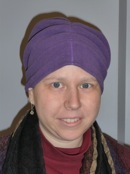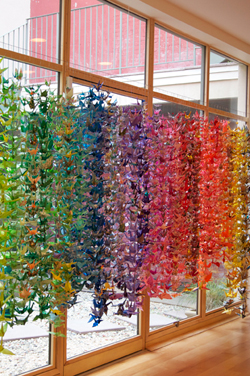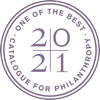Smith Center is honored to be the home of 3,500 colorful paper cranes, folded in honor of a young woman named Kirby who died in 2012 from an aggressive form of Ovarian Cancer. Our installation is a memorial for this incredible young woman, and a source of hope, healing, and love for all of our participants. The following story was written by Kirby’s parents to explain her journey and how these cranes came to be.
Learn how to fold your own Crane here
 In Memoriam: Kirby Sarah Weinstein Capen,
In Memoriam: Kirby Sarah Weinstein Capen,
4 May 1983-30 January 2012
Strange is our situation here on earth. Each of us comes for a short visit, not knowing why, yet sometimes seeming to divine a purpose…one thing we do know that we are here for the sake of each other…for the countless unknown souls with whose fate we are connected by a bond of sympathy.—Albert Einstein
We Began Folding Cranes in early spring 1972 as two American students traveling in Europe. At a nearly empty Swiss youth hostel, we met two Japanese young men and another student from Canada. After days sightseeing, the five young people from three countries shared cuisines in the hostel kitchen. (We made a tossed salad and the Japanese guys made sukiyaki: culinary novelties for each). Evenings, one of the Japanese men taught one of the Americans to fold origami cranes.
Twenty Years Later third grade students at the Burgundy Farm Country Day School studied Japan. They read the classic children’s book Sadaku and the Thousand Paper Cranes. Sadaku, exposed to radiation at Hiroshima when she was two, developed leukemia, and died at 12. Sadaku folded cranes hoping her wish to live would be granted. The class learned to fold simple origami. Then the mother of one of the third graders was diagnosed with breast cancer, which became a cloud of fear over the classroom.
One of students from twenty years before, Robert Weinstein, now father of a third-grader, Kirby Capen, began folding the cranes he learned to make in Switzerland. Judith Capen, the other American student and Kirby’s mother, finally learned how to fold origami cranes. Kirby watched and learned. Then she started teaching other third graders to make the paper birds, each one a prayer for recovery for their classmate’s mother. The teachers were astonished that their third-graders could master the complexity of the cranes. Somehow, in a magical classroom, in the throes of the helplessness of wanting to DO something with no useful action available, the entire class began making a thousand cranes. Cranes, came home from school with Kirby in grocery bags: cranes folded from tiny bits of paper, from gorgeous origami paper, from notebook paper, from catalog pages, folded well and curiously.
To keep track of the cranes Judith strung them by 25s, adding a base 25 math component.
It worked. The class, friends, families of third graders, even wait staff at restaurants during impromptu crane folding lessons, folded more than 1,000 cranes, presented them to the astonished mom, who recovered.
Over the Next Twenty Years the healing power of paper birds was called upon a number of times for friends and family facing illness and death. Sometimes people recovered. Sometimes they were buried with the failed paper wishes. Friends and family from Connecticut to Virginia had strings of cranes folded and strung for them by the Capen-Weinstein family.
 Cancer Cranes
Cancer Cranes
In August 2011, over four days, a relatively routine ovarian cyst became, instead, a friable necrotic malignancy. Kirby Capen, now 28, graduated in 2007 from Smith College with a BS in Engineering and a minor in studio art. She was a three-year veteran both of life in NYC and a job with a consulting engineering firm working in energy efficiency, “Saving the world one kilowatt at a time,” she said. She had just started a new job when it was surgery, cancer, then, just four weeks later, metastasis.
When her New York friends asked what she wanted while recovering from surgery, she said, “Cranes.”
After 25 days in the hospital in September, a diagnosis of a particularly awful cancer (small cell carcinoma of the ovary), and a first round of chemotherapy, dear friends, one a Smith classmate, set up a website for her, to help friends and extended family stay in touch, as well as schedule visits.
Some of Kirby’s story is captured on the web site: http://kirbystrong.wordpress.com/. The call for cranes went out through the website, Kirby herself said, “We have to give people something to do,” and over 6,000 cranes flew to our house. Big ones and ever-smaller ones. Cranes that had flown away to friends over the years in their need returned to our house for Kirby. Cranes came with hand-drawn patterns on the paper, hearts, stars, and abstract designs. Cranes were made of church and temple service sheets, pages of the New Yorker, a comic book, engineering paper, maps, calendars, wrapping paper, and, of course, origami paper.
People wrote on them:
- Psalm 91:4 “He will shelter you with his wings.”
- “Kirby rules, Love C—“
- “This is my first one.”
And MANY wishes for recovery.
Some people signed their cranes.
People who struggled to master crane-folding succeeded.
Judith, crazed with worry and feeling like Kirby’s sickness was like a train wreck in slow motion, began sorting the cranes by color to string them. The result was a screen of graded color, size and texture: a rainbow of folded paper birds.
In addition to the paper cranes, friends and family made and sent less traditional cranes of granite, steel, glass, and fabric. People bought her crane chopsticks with crane rests, crane jewelry, and a palm grass crane from in front of New York’s Metropolitan Museum. A friend of a family member, both nurses who got together to fold cranes and pray, sent her a photo of 25 Sandhill cranes in flight. A college classmate made and posted a crane video on her site. Cranes arrived, USPS, UPS, Fed-X, and hand-delivered in envelopes and boxes, singly, by the hundreds, and, in one case, a thousand. They came from Washington, Philadelphia, NYC, Boston, Vermont, South Dakota, Minnesota, California, London, Switzerland, and Hong Kong. Friends, coworkers, friends of friends, family, family of friends, elementary, high school, and college classmates, children she baby sat for and their parents, and children she’d never met in classes from pre-school through high school made cranes for her. One crane, with her name on it, was tucked in the Western/Wailing Wall. They sent wishes and hope while there was hope and prayers for wings to fly away on when there was no hope left. Images of her in flight were so much better than her reality.
At last count the total was around 6,700, not counting cranes given away, to others ailing, to children, strings and singletons to nurses and caregivers (a pink string to the nurses of the cancer floor at WHC in October, Breast Cancer Awareness month…). Kirby herself, dying, initiated a number of the gifts, sharing the hope. Giving some of her cranes away probably enhance their power.
Kirby Sarah Weinstein Capen, died at home, on January 30, 2012, five and a half months after her surgery, the same home to which she was brought at five days old. She breathed her last in a room with two walls curtained in cranes, a parent holding each hand, surrounded by love and cranes.
She was buried with some of her cranes; some of her cranes went home with mourners. Cranes continue to appear at her grave, “…exposed to the elements, slowly dissolving, and becoming tattered as the wish is released” in the Japanese tradition and a string of mylar cranes flutters above her, hung from a cherry tree overhanging her resting place…
This Project
When Kirby was first sick, we knew the power of cranes to communicate love and hope. What we didn’t know was how sick she was and we only imperfectly understood how wide was the reach of her short life. Through her simple request for cranes the community of people who cared for her created a powerful collective piece of art work, originally intended to give strength, now a memorial to her and a testimony to the strength of community.
Sharing this story and this art with a wider community keeps Kirby and her cranes flying in the world. A living memory.

 Kirby's Paper Cranes brighten the program space at Smtih Center on U Street in Washington, DC.
Kirby's Paper Cranes brighten the program space at Smtih Center on U Street in Washington, DC.